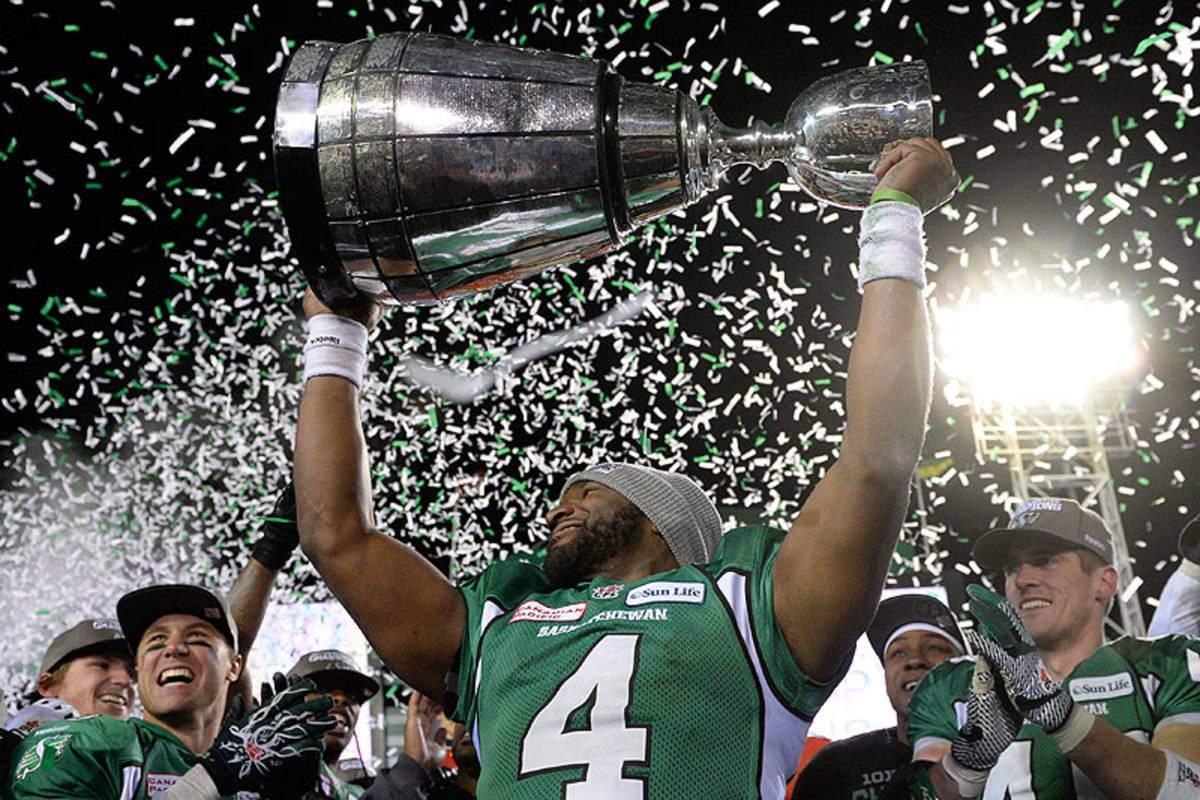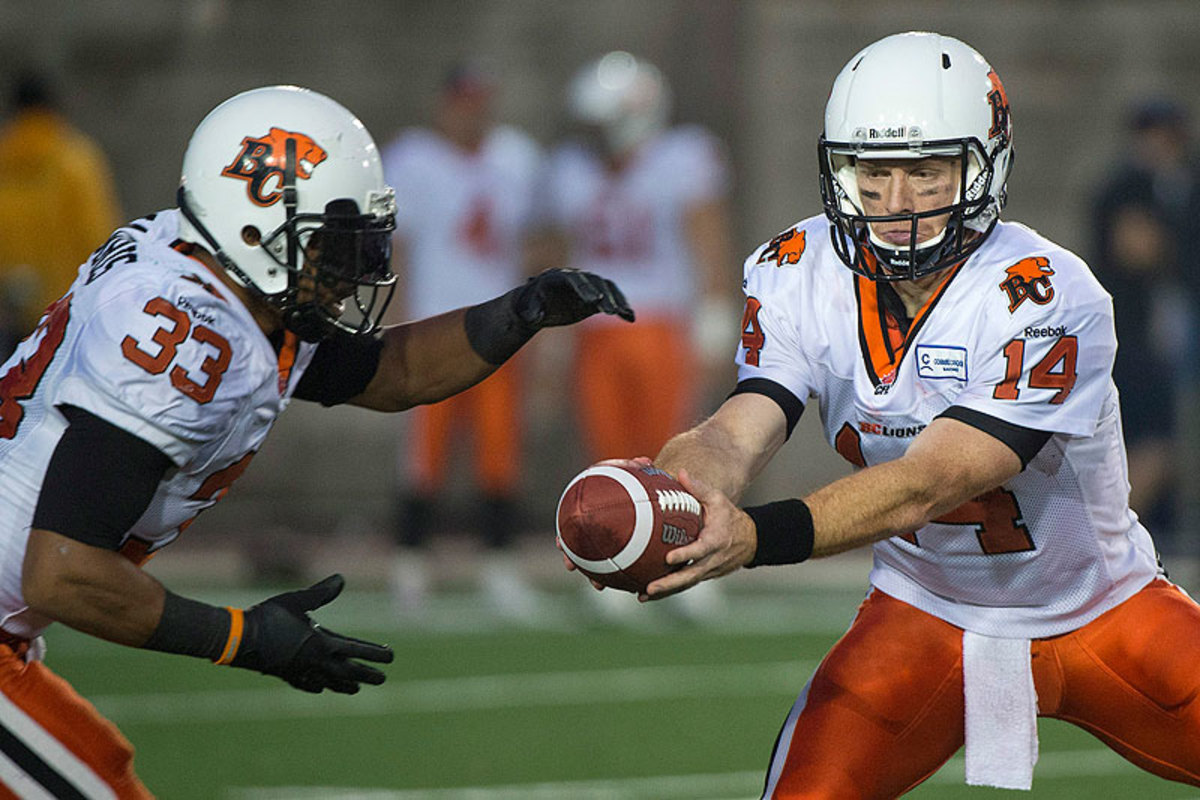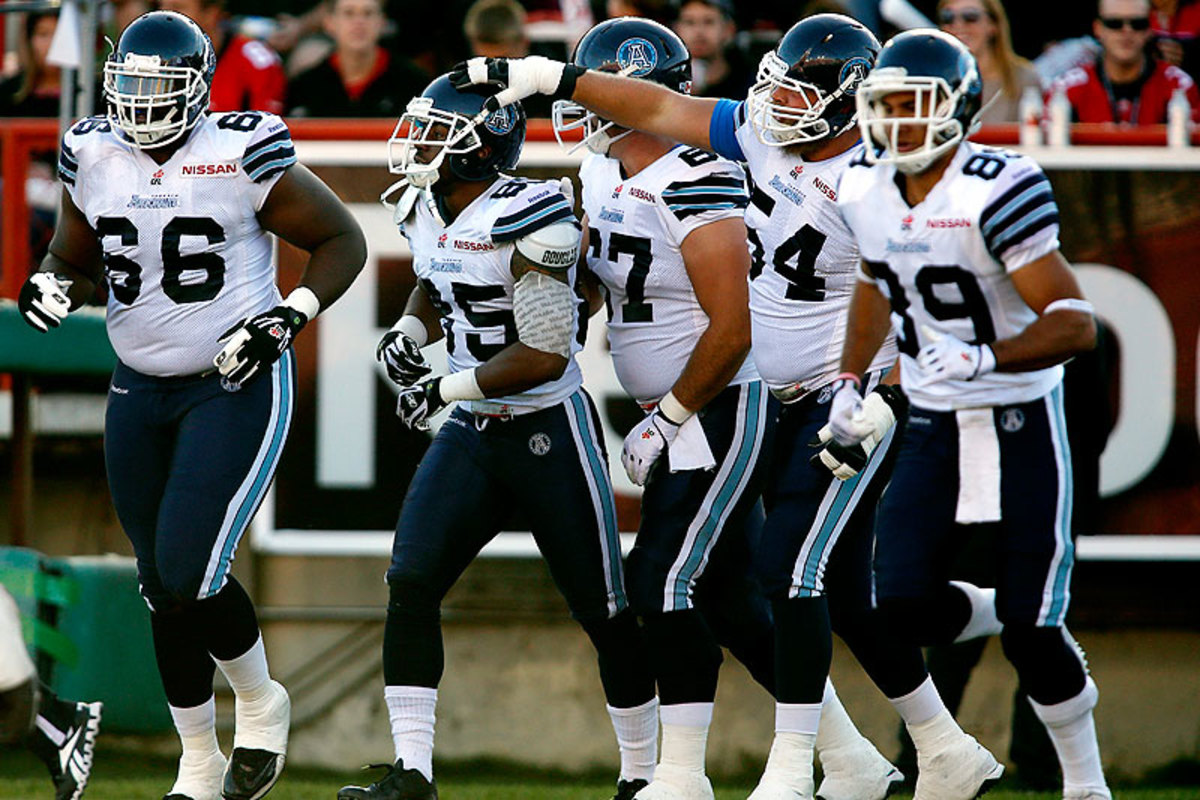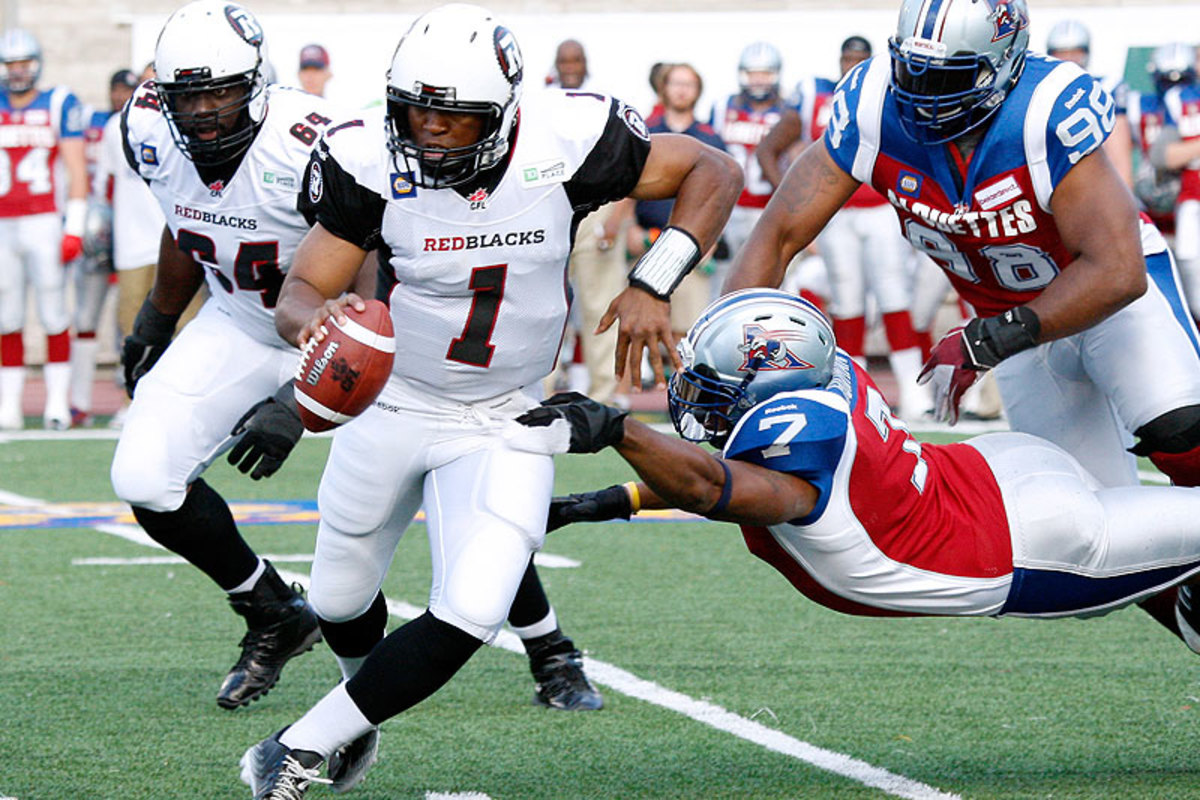Welcome to Canada Week

Note from editor-in-chief Peter King: Today opens Canada Week at The MMQB. It’s the opening week of the Canadian Football League season—the league traditionally plays from the end of June until the end of November, with the league championship, the Grey Cup, always happening around our Thanksgiving. We’re trying something novel here at our site: We’re covering three CFL games, with Toronto at Winnipeg on Thursday night (our Jenny Vrentas will be on site) and we’ll have some other features on the site to tell you about the game up north. I'll have a full explanation at the end of the column, in an abridged Five Things I Think I Think.
Now for this week’s Monday Morning Quarterback guest columnist, Chicago Bears coach Marc Trestman, on his five seasons as a Canadian Football League head coach.
CHICAGO — I appreciate the opportunity to share some thoughts on the Canadian Football League this morning—and I am grateful to The MMQB for devoting some time covering the opening week of the CFL season. From 2008 to 2012, I had the privilege of coaching the Montreal Alouettes, one of the flagship franchises in the CFL, before becoming the head coach of the Chicago Bears in 2013. I never looked at the job as a stepping stone to a head coaching position in the NFL, but was simply grateful to owner Bob Wetenhal and general manager Jim Popp for the opportunity to become a head coach and to serve the players and entire organization as well as their great fan base.
I can also tell you I absolutely loved every minute of my time in Montreal, one of North America’s great cities. I also loved and respected the players and coaches, as well as the brand of football played in the CFL.
There are now nine teams in the CFL, and because of that there is a great deal of familiarity between the organizations. The league itself is tradition-filled and more than 100 years old. Each team plays each other up to three times during the 18-game season. Here are some more CFL nuances:
- The game is played on a 110-yard field with 20-yard end zones.
- The field is 65 yards wide (compared to the NFL’s 53 yards), with a 20-second time clock between plays. That leads to action-packed football.
- There are only three downs to make 10 yards, not four.
- They play 12 players to a side, and the defensive line must line up a yard off the ball.
- Six eligible receivers can be in motion prior to the snap.
- On kicking teams, there are no fair catches, which makes for a very exciting punting game with the wide field.
Welcome to Canada Week
There are nine teams in the CFL, including: the Winnipeg Blue Bombers (Trevor Hagan/The Canadian Press/AP)

The Saskatchewan Roughriders, the reigning Grey Cup champions (Frank Gunn/The Canadian Press/AP)

The Edmonton Eskimos (Jeff McIntosh/The Canadian Press/AP)

The Calgary Stampeders (Jason Franson/The Canadian Press/AP)

The B.C. Lions (Graham Hughes/The Canadian Press/AP)

The Montreal Alouettes (Graham Hughes/The Canadian Press/AP)

The Hamilton Tiger-Cats (Frank Gunn/The Canadian Press/AP)

The Toronto Argonauts (Jeff McIntosh/The Canadian Press/AP)

The Ottawa Redblacks (Richard Wolowicz/Getty Images)

By the way, when I arrived in Montreal for training camp in May 2008, not only did I have to learn a new game, but I had forgotten that Montreal was bilingual (French first, English second) and as culturally diverse as any city in North America. We always had a handful of bilingual players on our teams.
In the CFL, all the games are on national television: TSN, the Canadian sports channel. The Grey Cup—the CFL’s championship game, played in late November every year—is the equivalent of a national holiday in Canada, the same way we treat the Super Bowl in the United States. Unlike the NFL, the CFL is made up of stadiums with capacity around 30,000. People ask me about the players who play the game in Canada and I always tell them they are the same as the NFL players. Many CFL players had the chance to play in the NFL briefly, or were late cuts in NFL camps over the years.
Another important difference between the CFL and NFL: the makeup of the teams. In the CFL, you have a 42-man game-day roster, and 20 of the 42 players must have Canadian heritage. The two quarterbacks don’t count against the ratio and you have to start seven Canadians among your 24 starters. But, there is no difference in the competitive makeup of each player. The men in the Montreal locker room were essentially no different than the men in our Chicago locker room. The players truly love the game, train extremely hard in the off-season, are highly competitive and “football intelligent,’’ and the game is as important to them as the NFL players I have coached. The only difference is the CFL player salary is significantly less than the NFL player. The CFL has a collective bargaining agreement, but the salary cap is $125 million lower than the NFL’s this year.
Trestman coached CFL legend Anthony Calvillo for five of the quarterback's 20 seasons. (Ryan Remiorz/The Canadian Press/AP)

When the games are played, no one’s thinking much about the salary cap, however. The population in Canada is about 30 million. In 2009, we played the Saskatchewan Roughriders in the Grey Cup. The TV ratings were incredible—43 percent of the entire nation tuned in to watch that game, the biggest TV audience to watch any show in Canada all year. There have been 102 Grey Cup games, and they’re always such a matter of civic and national pride. The week of the Grey Cup in late November becomes a week-long national holiday. I loved coaching in those games.
CFL football is a fast and exciting game. I never really changed my football philosophy very much to fit the CFL—because I was convinced you could play the same way we do in the NFL. But without Anthony Calvillo, the all-time leading passer in Canadian football history, the support of GM Jim Popp and the entire organization with so many good football players, I am sure it would have not been possible.
People have asked me what I learned in my five seasons in the CFL, and how it prepared me for the NFL. The simple answer is there’s no way I’d have been as prepared to be an NFL head coach without my five years in Canada. I’d had 11 stops as an assistant coach in college or pro football before I was hired by Montreal. I found that being a head coach in Canada was a great training ground for being a head coach in the NFL.
On page 2, I'll explain a few lessons I learned, and how I got better as a coach in Montreal.
High profile players, like Toronto's Ricky Ray, can make well into six figures, but the average salary of a CFL player is around $80,000 per year. (Sean Kilpatrick/The Canadian Press/AP)

1. The CFL is professional football. It’s a serious business, with incredible tradition and a countrywide love of the game. Popp and I worked together daily to put the best product on the field that we could. It’s the same with our GM in Chicago now, Phil Emery. Phil is a tremendous leader, evaluator of talent, a great sounding board, highly intelligent and a tremendous support system. He works tirelessly to improve our personnel on a daily basis.
2. It's a numbers game. Just working through the maintenance of your football team every day was a great learning experience for me in Montreal. For instance, because of the ratio I discussed earlier and the 42-man roster, where seven Canadians have to start, an injury to a Canadian player is significant. He must be replaced by a Canadian. If the Canadian is not replaceable at the same position an “import” (or “American”) player must be benched. So the dynamic of preparation every week is different, and a little more difficult, than it is in the NFL. You’ve got to have development players in the pipeline. Many teams in Canada will have five starting offensive linemen from Canada as we did in Montreal so skill positions could be occupied by U.S. players,
3. Money matters. The minimum salary for a CFL player is $45,000, about 12 percent of the NFL minimum … but the average team in the CFL might take in about 15 percent of what an NFL team will earn in a year.
4. The West Coast is effective in the Great White North. The biggest X-and-O lesson I learned in the CFL was “customizing” the West Coast Offense for the shotgun offense that’s used in Canada. In 1995, as the offensive coordinator in San Francisco, I got to know Bill Walsh, and I learned the West Coast Offense as Bill, Mike Holmgren and Mike Shanahan had taught it. But it was all done with the quarterback under center. In Canada, with all the motion and how fast everything is at the start of every play, it was better to start from the shotgun; we were 100 percent shotgun in Montreal. When I went to Canada, we decided that even though we had a wider field, we were going to design our passing game as if it was an NFL field. I never thought I was smart enough to figure out the CFL passing philosophy and use of the field, so honestly, I never tried. With Anthony Calvillo, an extremely smart and accurate passer—the Drew Brees of Canada—we were able to get this done during a very short two-week training camp.
We were fortunate to play in the Grey Cup my first year, and lost. Then we won it the next two. We had highly competitive teams all five years. We had an outstanding coaching staff, a high character team with good players who truly loved the game and the great Calvillo, who retired last season after setting most of the passing records in league history.
The rules in Canada were brilliantly conceived. It’s more of a mental challenge on game day. For example, on a missed field goal, the kicking team gets a point. But if the opponent runs it out of the end zone, the point is taken off the board. There are many tedious rules like this that make it challenging to manage a game. But the rules make sense and are tied to making the game extremely challenging from a game management point of view.
Because you have three downs to make a first down instead of four like U.S. football, most people would say, “You’ve got to make a first down in two downs, or punt on third down.” But because the defense is a yard off the ball, if you are third-and-one or less, most teams go for it. So if you make nine yards on two downs your chances of moving the chains are very good. The kicking game is extremely exciting. Because there are no fair catches, the covering team has to leave a five-yard halo around the returner so he can catch the ball. The return game therefore has more chances for explosive plays. With the wider field, the quicker players can make more things happen.
Trestman won two Grey Cup titles, including a dramatic, last-second victory in 2009. (Ryan Remiorz/The Canadian Press/AP)

Finally, you are never out of a game in the CFL. In the final three minutes of each half the clock stops after every play. With three-down football, you can have five or six exchanges of possession in the final three minutes. There is no protecting the lead in the CFL, believe me. I can give you a great example of that.
In the 2009 Grey Cup, against Saskatchewan, the game was played in Calgary. We got off to an awful start, and we were down 17-3 at the half, then down 27-11 with 10 minutes to go. Then everything came together for us on offense, defense, and special teams. Our players made big plays at exactly the right time. We got to within 27-25 with five seconds left, and our kicker, Damon Duval, lined up for the last play of the game, a field goal. He kicked … and missed. Right away, flags began to fly, and Saskatchewan picked up the missed field goal and started running downfield. But the call was against Saskatchewan—13 men on the field. That’s a 10-yard penalty. So with no time left on the clock, we got to try a 33-yard field goal, and Damon made it. We won, 28-27. The stars were aligned. It was really an act of God, and a great illustration of what happens when the ball changes hands so often in three-down football.
The Grey Cup parades we had in Montreal a few days after the 2009 and 2010 titles were incredible. Around 500,000 people filled the streets of Montreal for those celebrations. Seeing men, women and children with smiles on their faces was awesome. The best part of winning those two Grey Cups was having the privilege during exit meetings to remind the players to “tell our story.” The story, they knew, was about the journey we had taken like all championship teams do—overcoming adversity and success, the respect and humility in our locker room, and the friendships we had made over our time together. Finally how we gave up part of ourselves to be part of something bigger and that doing so was well worth it. These ideals had resonated throughout the organization.
My time in Montreal made for a very smooth transition to the Bears. I hope you get a chance to see some Canadian football this summer, while you’re waiting for the NFL to begin. I know I’ll be watching when I get the chance.
Travel Note of the Week
In the CFL, you don’t travel on charter planes the way you do in the NFL. We traveled on regular commercial flights or trains in my five years up north, and once, we had a pretty interesting experience flying out of the Montreal airport for a game in Calgary. We were weather-delayed for almost nine hours on a stop in Toronto. We wound up having two walk-through practices in a closed section of one of the terminals. There was one person in the space when we arrived—a man playing a cello. He had as much right to the space as we did. So we held our walk-thru there, while the guy played his cello. I give our guys credit: They were not distracted by the guy playing the cello. We just focused in on getting our work done.
Five Things I Think I Think
The Things I Think are being done by The MMQB’s editor-in-chief and normal author of the column, Peter King, to explain our Canada coverage over the next week.
The MMQB's Canada Week
Monday—Marc Trestman: Welcome to Canada Week
Tuesday—Doug Flutie: Reflections on my time in CFL
Wednesday—Bruce Arthur: The CFL's small-town charm
Thursday — Emily Kaplan: CFL players' offseason lives
Friday — Jenny Vrentas: Toronto-Winnipeg opening night
Monday — Peter King: MMQB from Calgary and Regina
1. I think I’d like to thank Marc Trestman for kicking off our CFL coverage—seeing he’s the NFL guy most well-versed on the Canadian landscape. I’d also tell you this: Over the years we’ve probably had 30 or so people guest-write this column, and I don’t recall one who wanted every word just so the way Trestman did. He and I went back and forth four or five times with corrections and additions. I can see why his players all say he’s a great detail guy. He certainly was with me on this column.
2. I think you’ll enjoy the rest of the week’s guest-column CFL stuff. Tuesday we’ll give you Doug Flutie reflecting on the great time he had in his eight-year CFL career, about how he went up there almost out of necessity and got to love it more than the NFL game … and also about how he thinks with the advent of the spread and hurry-up offenses and the lack of prejudice toward short quarterbacks he’d have a better chance of winning a long-term NFL starting job today. Wednesday: Noted and respected Canadian sportswriter Bruce Arthur—formerly of the National Post, now with the Toronto Star—writes about the CFL and its small-town charm.
3. I think this is the rest of our coverage plan for the week, with some flexibility built in based on what we find in our reporting:
a. Emily Kaplan on the heavy community involvement of players, with even the great ones (many of them) working jobs in their team’s cities in the off-season.
b. Jenny Vrentas at Toronto-Winnipeg, filing overnight Thursday after the evening game that opens the CFL season, with the color of the game and the crowd.
c. I’ll be at two games: Montreal at Calgary on Saturday afternoon, and Hamilton at Saskatchewan on Sunday evening. I’ll be writing a CFL-apolooza for my Monday Morning Quarterback next week, live from Regina.
d. I’ll be driving from Calgary to Regina, and if all goes well Saturday night, I may just have a beer in Medicine Hat. Now, how many people outside of those on the great prairie can say they’ve had a beer in Medicine Hat? Suggestions appreciated, by the way.
e. A week from tomorrow, my Tuesday column will be almost all from you. I want to hear about our coverage—whether you care, whether you don’t, whether you just want a break from football, whatever. So please send your comments in next Monday, either by email or in the comments section below my column, and we’ll print as many of them as we can.
4. I think my big boss at Sports Illustrated, Paul Fichtenbaum, had an interesting comment when I told him about our “Canada Week” plans. “Peter,’’ he said, “how many people are going to read this?’’ I told him I didn’t know, but part of what I want to do at The MMQB is to troll the waters with different ideas. If our numbers are very low, we get the message; we won’t cover the CFL anymore. If they’re high, well, we’ll probably cover the Grey Cup this year. So it’s up to you, the readers and video viewers (yes, we will have a videographer with me on the weekend in Alberta and Saskatchewan) to determine whether we do more CFL coverage. I will say that I have a good feeling about it. When I said on Twitter we planned some CFL stories and I wanted to know where to go, I got a landslide of responses—so many of you say we’ve got to go to Saskatchewan because of the fervor of the ‘Rider fans—and I’m hopeful that all of you will come back to the site often this week and read what we’ve got.
5. I think, finally, I’d love to hear your suggestions for Vrentas in Winnipeg and me in Calgary and Regina. What’s fun to do? Who should we write about? What good fan stories are there? Got good local places for us to try? How about the best tailgating spots in the three venues? Tweet us @JennyVrentas and @SI_PeterKing with your ideas. Thanks. Really looking forward to what should be a fun week.

